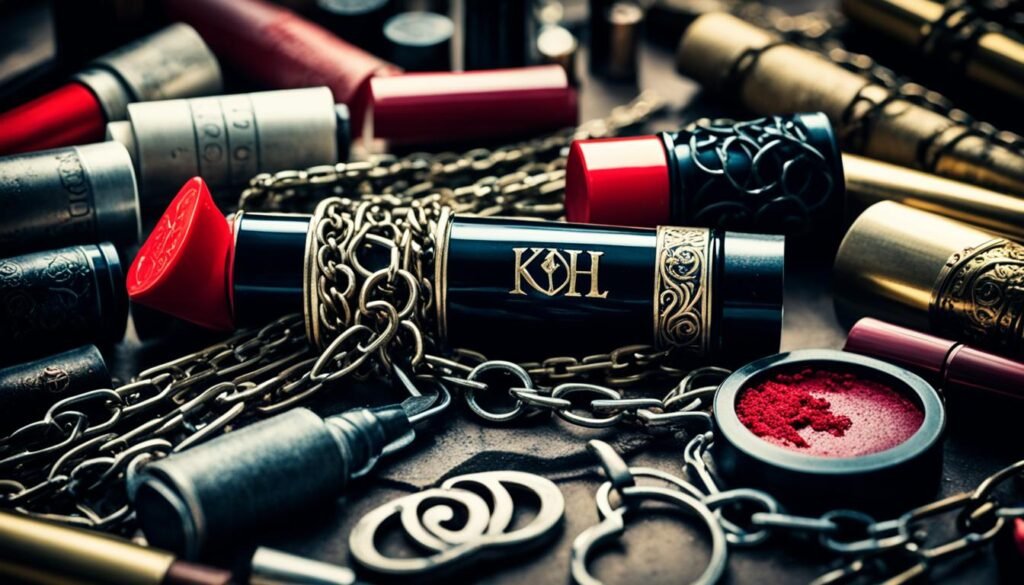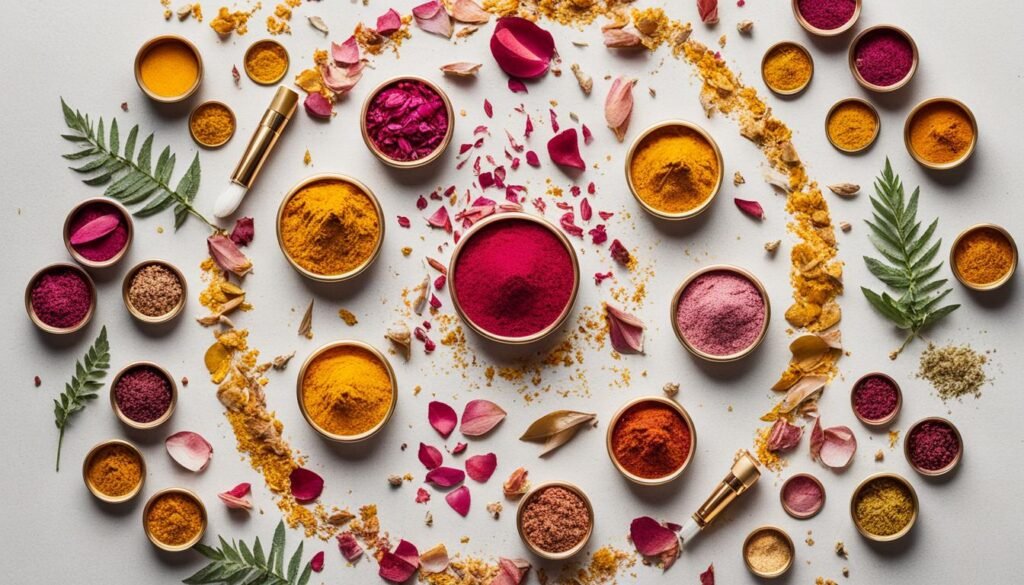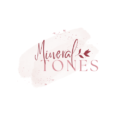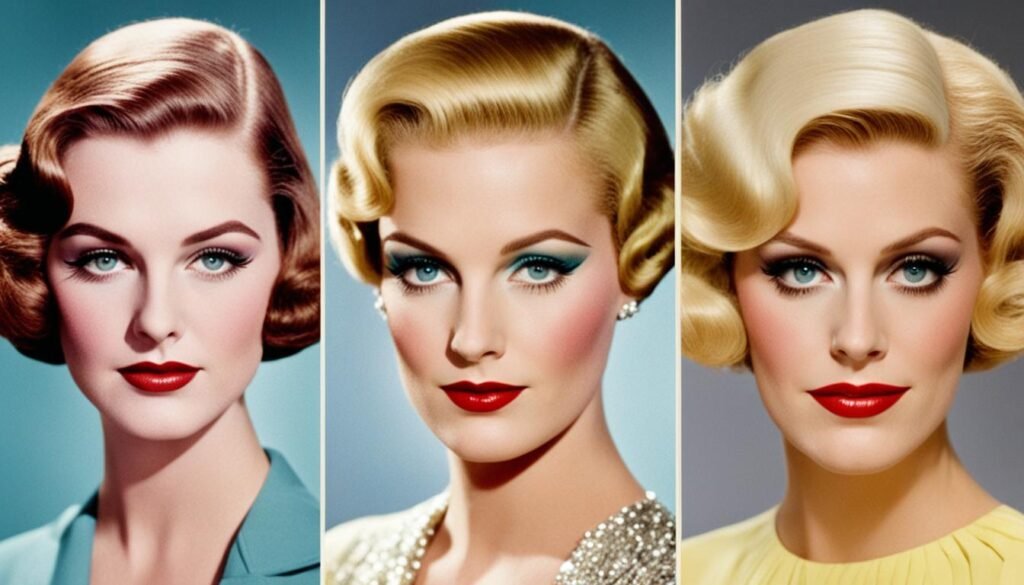Have you ever wondered how your makeup routine has evolved over time? From ancient civilizations to the modern era, makeup trends and techniques have undergone a remarkable transformation. The history of makeup is full of fascinating stories, from the use of natural elements in ancient Egypt to the bold and vibrant looks of the 1980s. So, how exactly has your makeup changed throughout the years?
In this article, we will take a journey through the beauty trends history and explore the cosmetic transformation that has shaped the way we do our makeup today. From the dangerous ingredients in Victorian-era cosmetics to the rise of inclusive beauty products, we’ll uncover the factors that have influenced this evolution and challenge common beliefs about makeup. So, get ready to discover the captivating story behind the changing face of beauty.
Key Takeaways:
- Ancient Egyptians used natural elements such as minerals and clay pigment for their cosmetics.
- Victorian-era cosmetics often contained toxic ingredients like lead and arsenic.
- Makeup was prohibited during the Middle Ages, but women still found ways to defy societal norms.
- The 20th century brought significant advancements in makeup, including the invention of new products like lipstick and mascara.
- Hollywood stars have had a major influence on makeup trends throughout history.
Ancient Makeup Trends in Egypt
The history of makeup can be traced back to ancient Egypt. Egyptians were known for their innovative use of cosmetics and natural elements to enhance their beauty. Their ancient makeup techniques laid the foundation for the evolution of makeup trends that would shape the beauty industry for centuries to come.
One of the key aspects of ancient Egyptian cosmetics was the use of natural ingredients. Egyptians used minerals and clay pigments to create a wide range of makeup products, including foundation, eye shadow, and lipstick. These natural elements provided a distinct color palette that reflected the richness of the Egyptian culture.
The most iconic element of ancient Egyptian makeup was the use of kohl. Kohl, made from lead sulfide, was used to darken the eyes and create striking eyeliner looks. The use of kohl not only enhanced the beauty of the eyes but also had practical purposes, as it protected the eyes from the harsh desert sun.
Ancient Egyptian women and men embraced makeup as a form of self-expression and a symbol of their social status. It was common for both genders to wear elaborate makeup looks, including thick eyeliner and bold eyeshadow colors. This practice demonstrated their appreciation for beauty and their desire to present themselves in an aesthetically pleasing manner.
Ancient Egyptian Makeup Techniques
Ancient Egyptians had sophisticated makeup techniques that allowed them to create intricate looks. They would crush minerals and natural pigments into powders and mix them with oils or water to form paste-like cosmetics. They applied these cosmetics using various tools such as brushes, Q-tips, or their fingertips.
“Ancient Egyptian makeup was an art form in itself. The precision and attention to detail in their makeup application were truly remarkable.” – Beauty historian, Samantha Johnson
Their makeup application techniques emphasized enhancing the natural beauty of the individual. They would contour their features by strategically applying different shades of makeup to create dimension and emphasize their best features. For instance, they would highlight their cheekbones, define their eyebrows, and elongate their eyes using kohl.
The mesmerizing beauty of ancient Egyptian makeup continues to inspire modern beauty trends. From the use of natural elements to the iconic kohl eyeliner, the influence of ancient Egyptian cosmetics is evident in the way we approach makeup today.
Ancient Egyptian Makeup in Modern Beauty
Today, the allure of ancient Egyptian makeup is often celebrated in the beauty industry. Many cosmetic brands draw inspiration from the rich history of Egyptian cosmetics, incorporating natural ingredients and earthy tones into their products.
Mineral-based cosmetics have gained popularity, offering a nod to the ancient Egyptians’ use of natural elements. Brands like Mineral Tones and Mineral Sparkle feature a wide range of mineral-based makeup products that embrace the ancient tradition of enhancing natural beauty.
“Ancient Egyptian makeup techniques show us the power of natural beauty. By embracing the use of natural elements, we can create timeless makeup looks that enhance our features in a subtle and elegant way.” – Makeup artist, Emma Thompson
The influence of ancient Egyptian makeup can also be seen in the ongoing trend of winged eyeliner. This classic and versatile eyeliner style, inspired by the elongated eyes achieved with kohl, remains a staple in many makeup routines today.
Ancient Egyptian makeup is a testament to the enduring allure and power of cosmetics throughout history. From the natural elements to the iconic kohl eyeliner, their beauty practices have left an indelible mark on the world of makeup.
Dangerous Ingredients in Victorian-Era Cosmetics
During the Victorian era, women sought to achieve a pale and delicate complexion through the use of cosmetics. However, what they may not have realized at the time was that some of these beauty products contained toxic ingredients that posed serious risks to their health. Poisonous ingredients such as lead and arsenic were commonly found in Victorian-era cosmetics, leading to toxic beauty regimens that would have long-term consequences.
Brands would include small doses of arsenic in products such as face powders and creams in an attempt to achieve the desired porcelai
Makeup Prohibition in the Middle Ages
In the Middle Ages, societal views on makeup were shaped by religious beliefs and cultural norms. The Church deemed the use of makeup immoral and banned its use, considering it deceptive and sinful. Despite the prohibition, women in Europe continued to find creative ways to enhance their beauty.
Geranium Petals: Defying Societal Norms
During the Middle Ages, European women ingeniously turned to nature to achieve a touch of color on their cheeks and lips. Crushed geranium petals became a popular alternative to forbidden makeup. By applying these petals, women created a rosy glow that defied prevailing societal restrictions.

Despite the religious prohibition and strict societal views, women in the Middle Ages found ways to express their individuality and challenge traditional norms through the use of crushed geranium petals.
This period in history reveals the resilient spirit of women who, despite the makeup prohibition, persisted in their pursuit of beauty and self-expression. It is a testament to the enduring human desire to enhance one’s appearance, even in the face of societal constraints.
Evolution of Modern Makeup in the 20th Century
The 20th century witnessed remarkable advancements in the world of makeup, leading to the evolution of modern makeup as we know it today. From nourishing lipsticks in various shades and finishes to the invention of the mascara tube, these innovations revolutionized the application and aesthetics of makeup. Additionally, the introduction of pancake makeup in 1935 further transformed the industry, enabling movie stars to achieve a more theatrical and flawless appearance on the silver screen. Let’s explore these significant developments in detail.
Modern lipsticks underwent a major transformation in the 20th century. With advancements in cosmetic chemistry and formulation, lipsticks became more nourishing and accessible than ever before. Additionally, diverse shade ranges and finishes were introduced, allowing individuals to express their individuality through their lip color choices.
Mascara, an essential component of modern eye makeup, underwent a revolutionary change in the 20th century. The invention of the mascara tube with a wand applicator made application more convenient and efficient. This innovation made it easier for individuals to achieve voluminous and defined lashes, enhancing the overall look of their eyes.
“Pancake makeup,” invented in 1935, played a crucial role in transforming the appearance of movie stars on screen. It was a specialized type of foundation makeup that allowed for a more matte finish and higher coverage, ideal for the bright lights of the film industry. The advent of pancake makeup not only enhanced the visual impact of actors and actresses but also influenced the beauty standards of the time.
Evolution of Modern Makeup in the 20th Century
| Lipstick | Mascara | Pancake Makeup |
|---|---|---|
| Innovative formulation | Mascara tube with wand applicator | Introduced in 1935 for matte finish and higher coverage |
| Diverse shades and finishes | Enhanced lash definition | Popularized by movie stars |
The evolution of modern makeup in the 20th century marked a significant shift in the beauty industry. These advancements not only offered individuals more options for self-expression but also influenced beauty trends and standards. The contributions of lipsticks, mascaras, and pancake makeup continue to shape the way we approach and appreciate makeup in the present day.
Enduring Ingredients and Beauty Traditions
Despite the evolution of makeup, some ingredients and beauty traditions have withstood the test of time. These enduring practices highlight the long-standing desire for beauty throughout history.
Ancient Ingredients Still Present Today
One traditional makeup ingredient that has persisted throughout the ages is castor oil. This versatile oil was used in ancient makeup for its hydrating and nourishing properties. Today, it can still be found in some cosmetic products, including moisturizers, lip balms, and mascaras.

Timeless Beauty Practices
Beauty traditions have also endured over time, crossing generations and continents. One such example is the use of kohl, a traditional eye cosmetic that has been utilized for thousands of years in countries such as Egypt and India. Kohl, made from a mixture of natural ingredients like charcoal, antimony, and oils, is believed to enhance the appearance of the eyes and is still widely used today.
Similarly, the application of henna for temporary tattoos and hair dye has been a cultural practice in India and several other countries for centuries. Henna is derived from the leaves of the henna plant and creates a reddish-brown stain on the skin or hair, providing a natural and versatile form of self-expression.
The Enduring Beauty of Traditional Ingredients
Traditional makeup ingredients and beauty practices continue to captivate individuals who appreciate the connection to ancient traditions and the natural world. Incorporating these timeless elements into modern beauty routines allows for a harmonious blend of history and innovation, creating a unique and enduring beauty experience.
The Influence of Hollywood and Pop Culture
Hollywood stars have always had a significant impact on makeup trends. The iconic looks of actresses like Marilyn Monroe in the 1950s and Twiggy in the 1960s shaped the beauty standards of their respective eras. The explosion of color in motion pictures in the 1950s also influenced makeup trends, with emphasis on bold lips and dramatic mascara. Pop culture continues to inspire and shape makeup trends today, with artists on YouTube and Instagram setting new beauty standards.
Hollywood Icons and Their Impact
The glamorous Hollywood icons of the past not only captivated audiences with their talent but also left a lasting impression with their signature makeup looks. Marilyn Monroe’s sultry red lips and perfectly arched eyebrows became synonymous with timeless elegance and femininity. Twiggy’s mod-inspired eye makeup featuring heavy lashes and graphic eyeliner lines defined the 1960s beauty aesthetic.
“Iconic makeup looks from Hollywood stars have not only influenced beauty trends but have also become timeless symbols of femininity and glamour.”
The Beauty Influence of Films
The advent of color films in the 1950s revolutionized the beauty industry. Vibrant hues on the silver screen translated into a desire for bold and striking makeup looks off-screen. Actresses like Elizabeth Taylor and Audrey Hepburn showcased the power of a red lip and defined brows, influencing countless women to embrace these classic beauty elements.
“The portrayal of glamorous and captivating characters on the silver screen solidified the influence of Hollywood on makeup trends, giving rise to iconic beauty looks that are still celebrated today.”
The Power of Social Media
In the digital age, the influence of Hollywood has extended beyond the big screen. Social media platforms like YouTube and Instagram have become a breeding ground for makeup artists and beauty enthusiasts to share their talent and expertise. Influencers like James Charles and Huda Kattan have amassed millions of followers and have effectively shaped makeup trends and beauty standards with their innovative techniques and unique aesthetics.
“With the rise of social media, makeup artists and beauty enthusiasts have become the new trendsetters, inspiring millions of people around the world to experiment with different makeup looks and techniques.”
The Continued Evolution of Makeup Trends
As we move into the future, the influence of Hollywood and pop culture on makeup trends shows no signs of diminishing. The popularity of celebrity collaborations with beauty brands, such as Rihanna’s Fenty Beauty and Kylie Jenner’s Kylie Cosmetics, further highlights the deep-rooted connection between the worlds of entertainment and beauty. With a constant stream of inspiration from our favorite celebrities and online influencers, the possibilities for self-expression through makeup are endless.
The Rise of Inclusive Beauty Products
In the past, beauty products were often created with a limited range of skin tones in mind, catering primarily to women with light complexions. However, the beauty industry has undergone a significant transformation in recent decades, with a growing awareness of the need for inclusivity and diversity in cosmetics.
It was in the 1970s that cosmetic brands began to understand the importance of offering shades that catered to women of color. This marked a pivotal moment in the industry, as it challenged the previous beauty standards and acknowledged the diverse range of skin tones that exist.
This shift towards inclusivity opened up a world of possibilities for women of all backgrounds. It allowed more individuals to find products that complemented their specific skin tones, empowering them to express their unique beauty through makeup.
Today, many cosmetic brands have embraced inclusivity as a core value. They have expanded their product ranges to encompass a wide spectrum of shades, ensuring that all individuals, regardless of their skin tone, can find beauty products that are tailored to their needs.
By promoting diversity in cosmetics, these brands are not only meeting the demands of their customers but also promoting a more inclusive and equal beauty industry.
Minimalism and Natural Beauty in the 1970s
The 1970s marked a significant shift in beauty standards, as women began embracing a more natural and minimalist approach to makeup. Influenced by the women’s liberation movement and a desire to challenge societal expectations, women sought to express their authenticity and inner beauty through their makeup choices.
Gone were the heavy foundations and elaborate eye makeup of previous decades. Instead, women gravitated towards a more radiant and effortless look, with a focus on enhancing their natural features. Glowing skin became the epitome of beauty, and women aimed to achieve a fresh-faced and dewy complexion.
A quote from Mary Johnson, a renowned makeup artist during the 1970s:
“In the 1970s, women yearned for a break from the painted-on perfection of the past. It was a time of liberation, both social and personal. Minimalism became the new aesthetic, and natural beauty was celebrated. It was about embracing imperfections and letting your true self shine through.”
Light mascara was favored over heavy eyeliner, allowing the eyes to appear more open and natural. Soft, neutral eyeshadows were applied to enhance the eye shape subtly. Eyebrows were groomed but not overly defined, maintaining a soft and natural look.
The lips also embraced a more understated approach. Soft, muted shades like nude or light pink were popular choices. Instead of sharp and defined lip lines, a more diffused and blended effect was achieved, further enhancing the natural appeal.
The natural and minimalist makeup trend of the 1970s not only emphasized beauty but also empowered women to embrace their individuality. It offered them a sense of freedom, enabling them to showcase their true selves without conforming to societal expectations.
Effects of the Women’s Liberation Movement
The women’s liberation movement of the 1970s played a crucial role in shaping the beauty ideals of the decade. As women fought for equal rights and challenged traditional gender roles, they sought to redefine beauty standards as well. The natural and minimalist makeup trend became a symbol of women’s empowerment and a rejection of the restrictive beauty standards of the past.
With the rise of feminism and the women’s liberation movement, women embraced their natural beauty and encouraged others to do the same. They aimed to break free from the notion that makeup was necessary to conform to societal norms and instead promoted self-acceptance and self-expression.
| Key Characteristics of 1970s Minimalistic Makeup |
|---|
| 1. Glowing and radiant skin |
| 2. Light mascara for natural-looking lashes |
| 3. Soft, neutral eyeshadows |
| 4. Understated and muted lip colors |
| 5. Emphasis on embracing imperfections |
| 6. Celebration of individuality and authenticity |
The 1970s marked a transformative period in the beauty industry, as women rebelled against conventional beauty standards and embraced minimalist and natural makeup. This shift, influenced by the women’s liberation movement, empowered women to define beauty on their own terms and paved the way for the inclusive and diverse beauty landscape we see today.
Bright Colors and Bold Looks in the 1980s
The 1980s were an era of bold and vibrant makeup looks, characterized by bright colors and eye-catching designs. This decade witnessed a departure from the natural and minimalist trends of the previous years, as makeup became an expression of individuality and creativity. Pastel eye shadows, neon lipsticks, and dramatic eyeliner were all the rage, allowing people to experiment with bold and unconventional styles.
One of the key elements of 80s makeup was the use of intense and bright colors. Eyeshadows in bold shades like electric blue, hot pink, and vibrant purple were popular choices for creating dramatic eye looks. The goal was to make a statement and draw attention to the eyes, often achieved through the use of multiple shades and blending techniques.
Bright blushes in shades of coral, fuchsia, and peach were applied generously to the cheeks, creating a flushed and youthful appearance. Blush was not meant to be subtle in the 80s; it was meant to be noticed. The goal was to achieve a high-impact and vibrant look that complemented the colorful eyeshadow choices.
Thick eyeliner was another defining feature of 80s makeup. Whether it was in black or a bright neon color, eyeliner was applied generously along the lash line, often extending beyond the outer corner of the eye in a dramatic winged shape. This bold liner helped create a striking and edgy look, adding an element of intensity to the overall makeup style.
Overall, 80s makeup was all about embracing vibrant colors and creating eye-catching looks. It was a decade of self-expression and individuality, where makeup became an art form to showcase creativity and personality. From neon eyeshadows to bold blushes and thick eyeliner, the 80s pushed the boundaries of traditional makeup and encouraged people to embrace their uniqueness.
“The 80s were a time of creativity and self-expression in makeup. It was all about standing out and pushing boundaries, which is still celebrated today.” – Beauty Expert, mineraltones.com
Key Features of 80s Makeup:
- Bright and vibrant eyeshadows in bold colors
- Generously applied blush in high-impact shades
- Thick eyeliner, often in black or bright neon colors
Contemporary Makeup Trends and Influences
In today’s beauty landscape, makeup trends are constantly evolving, with influences coming from a wide array of sources. One of the most significant factors shaping the way we do our makeup is the rise of social media influencers. Platforms like YouTube and Instagram have given birth to a new generation of makeup artists who have gained massive followings and are setting the trend with their unique and innovative techniques.
These YouTube and Instagram artists, such as Michelle Phan and James Charles, have become trusted sources for makeup tips, product reviews, and tutorials. Their creativity, skill, and ability to connect with their audiences have turned them into influential figures in the beauty industry. By sharing their knowledge and expertise, they inspire millions of makeup enthusiasts worldwide to experiment with different looks and techniques.
The accessibility of beauty tutorials online has also played a significant role in shaping current makeup trends. With just a few clicks, anyone can access a wealth of information on how to achieve different makeup looks. From subtle everyday makeup to bold and artistic creations, the variety of tutorials available caters to all skill levels and interests.
Another driving force behind contemporary makeup trends is the constant innovation and extensive range of products available. Brands like Mineral Tones and Mineral Sparkle offer a wide selection of high-quality cosmetics designed to enhance and transform the face. With innovative formulas and diverse shade ranges, these brands cater to the diverse needs and preferences of makeup enthusiasts, allowing for greater creativity and self-expression in makeup application.

